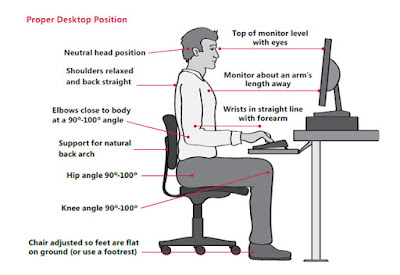If you work at a computer all day long, than you need to know the health problems causes by computer.
Cases of chronic disease called Repetitive Stress Injury (RSI), which are caused by long hours of continuous work on the computer, are rapidly being reported in the world these days.
 |
| Person suffering from RSI |
The computer operator leans his wrist on the keyboard for hours almost unknowingly. Due to which the claws are constantly bent upwards. The constriction produced near the wrist creates a constant pressure on the nerves as well as the muscles passing through it. After months or years, that part of the joint becomes numb and begins to tingle. In the long run, the same mold is formed in the elbow as in the case of claws. The elbow hinge, which is constantly leaning on the handle of the chair while operating, becomes weak.
The biggest trouble is created by computer monitor screen, from which a daily dose of (dim) X-rays emitted is harmful to the operator's eye. That leads to tears, inflammation in the evening and pain in the eyes.
The revolution in the field of computers can no longer be stopped, but like television, computer has become a part of the furniture of many homes. If this 'furniture' is planned in an ideal way, it is possible to get some relief from the disease of RSI.
This means that if the desktop computer's desk itself is not faulty, then the person operating the computer has to suffer minimum physical problems. A plan prepared by experts is shown in the below diagram.
According to this plan, the height of the table on which the computer is to be placed should be a maximum of 28 inches above the ground level. The minimum distance between the monitor screen and the eye should be 20 inches and the maximum distance should be 26 inches.
According to this plan, the height of the table on which the computer is to be placed should be a maximum of 28 inches above the ground level. The minimum distance between the monitor screen and the eye should be 20 inches and the maximum distance should be 26 inches.
It is also important that the head stays upright during the operation and that the angle between the monitor and the eye is at least 10 and at most 30 degree. The keyboard on the desk has to be arranged in such a way that the operator can keep his paws in a straight line and at the same time make an angle of about 90 degree elbows.
The condition where the finger bends only slightly during data entry is medically ideal. The design of the chair should be such that its seat can be adjusted to a convenient level. There should be a distance of at least 24 inches between the chair and the table too.
The most important thing is that if the operator takes a break of five to seven minutes on an average every hour and during that time relaxes the muscles of the wrists as well as the elbows, then there is no question of recurrence of a number of ailments under the heading of RSI.
An interesting survey found that in the case of operators who are accustomed to smoking cigarettes more often, the chances of suffering from RSI computer-borne disease are reduced by 50%. Intervals to quench the thirst for cigarettes provide much needed relief to their eyes, waist, paws and elbows.
In short, a reasonable desk for a desktop computer, as well as a reasonable rest for the body under the pretext of a short break while operating, naturally reduces the risk of developing RSI.




Post A Comment:
0 comments so far,add yours
Please do not add any spam link in the comment box